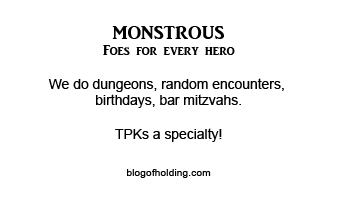Last week, I told you all about The 2nd Mile of The Ten Mile Tower! This week, I will detail the third level of the tower, which is possibly the most dangerous level so far!
Main Premise: The Ten Mile Tower literally spans ten miles into the air, touching the stars themselves. Due to its magical nature, anyone entering the tower has 24 hours to exit or the doors of the tower will close to them forever, whether they are still inside or not. Thus players have only one opportunity to take an extended rest while within the tower and have little room to dawdle as they make their way up its thousands of levels. Many different monsters have become trapped in the tower or reside here of their own accord, and each mile is presided over by a powerful creature and its minions, making this an exciting and varied adventuring location. Read more about The Ten Mile tower HERE.
Note: Is it possible to climb up and down ten miles within twenty four hours? Maybe not! If it is impossible, just imagine that the tower twists time subtly so that those hours of climbing are magically condensed into shorter periods of time. Say things like “Your map indicates that you have reached the third mile already and yet it feels as if only a short time has passed.”
Overview of the 3rd Mile
The third mile appears eerily empty with many areas closed off and in disrepair. The only evidence of life is the occasional torch that dots the walls, providing shadowy light. Giant webs also dot certain levels as the PCs advance upwards.
Drow reside on these levels, but they don’t make themselves known to the PCs. They cultivate spiders as pets, which are not so subtle. From time to time the players may stumble upon a giant spider or two, which are easy enough to slay. However, if the DM wants to test the PCs resources, they may throw an encounter at them consisting of giant spiders and drow that decide to test the strength of the PCs and seek to escape to report to their masters if things go poorly.
As the PCs travel, they inevitably enter into a room where a drow warrior is hiding. The drow observes their approach and then sneaks off to alert his superiors, who reside in a temple at the top of this level. The drow warrior should make a stealth check versus their passive perception. If a player succeeds, they notice the drow darting off to warn his mistress, a drow arachnomancer.
A PC may trail the drow to a dark and gloomy temple at the top of mile two and listen to his report. The arachnomancer responds that they will prepare for the arrival of their guests. She then instructs the drow to take up certain tactical positions but not to attack unless she gives the go ahead.
(more…)











